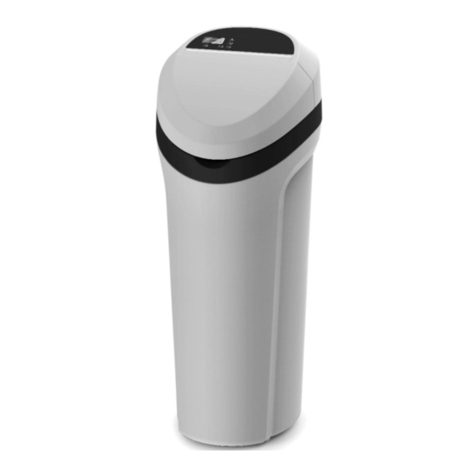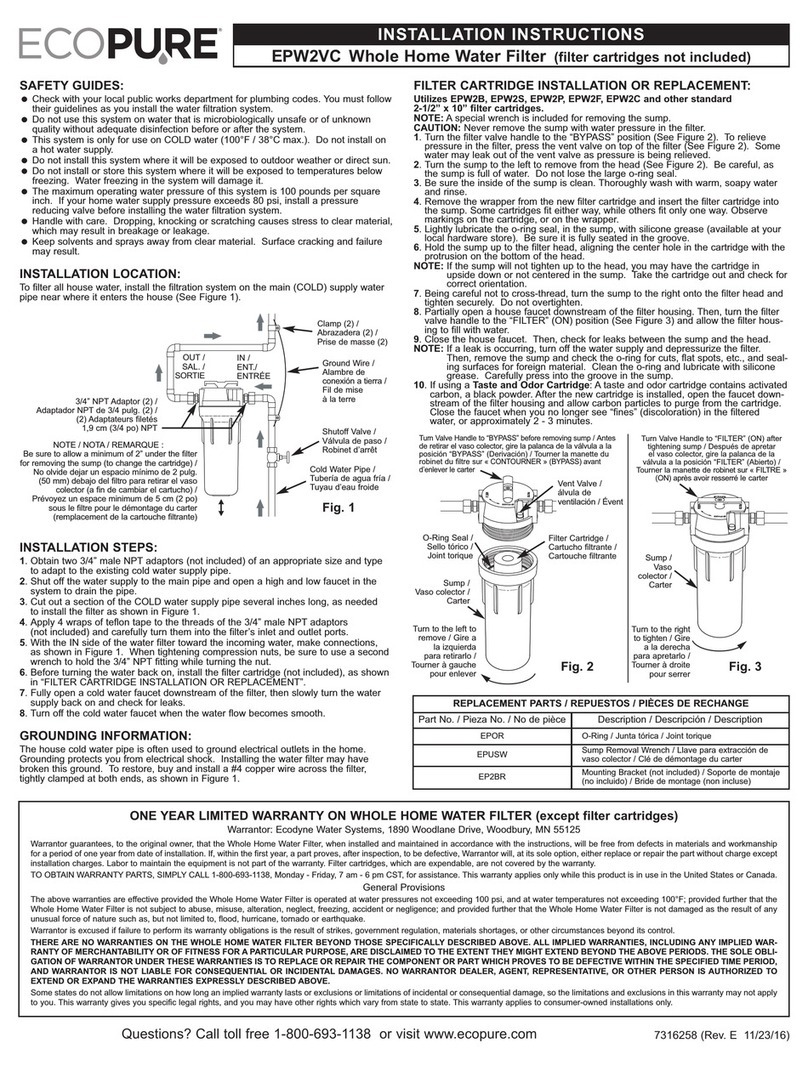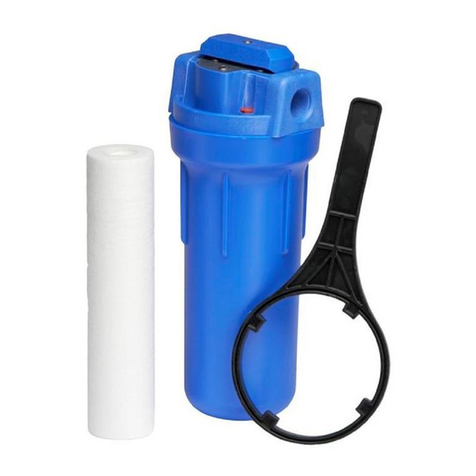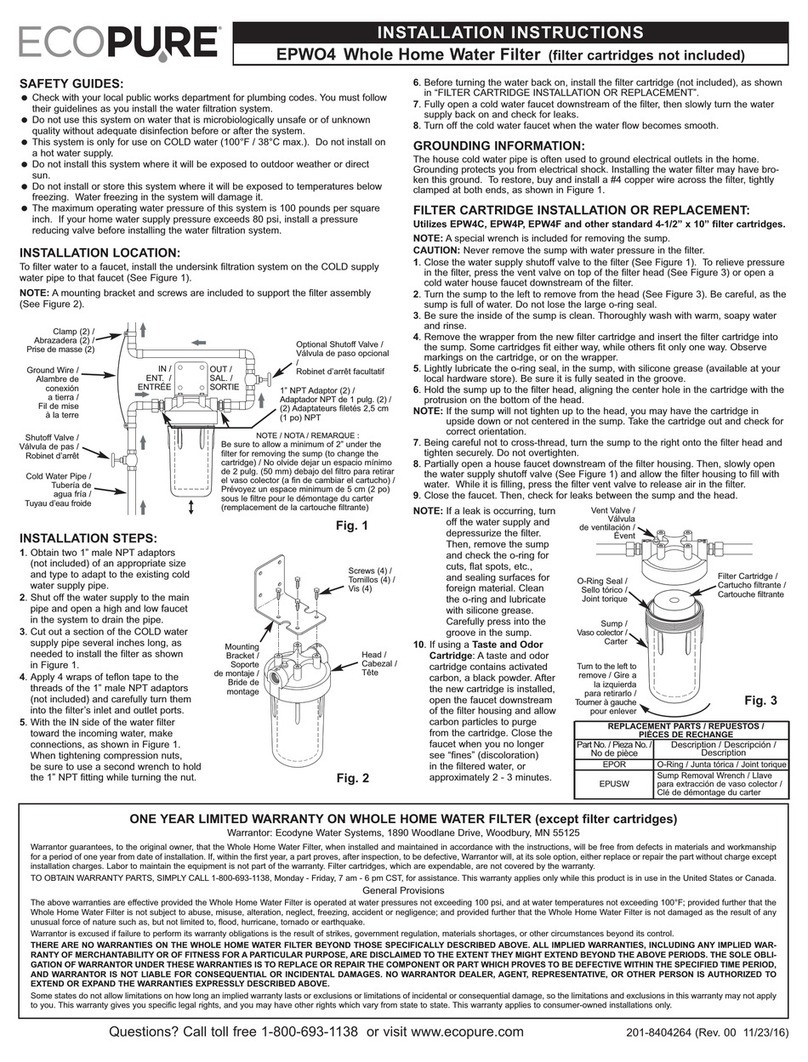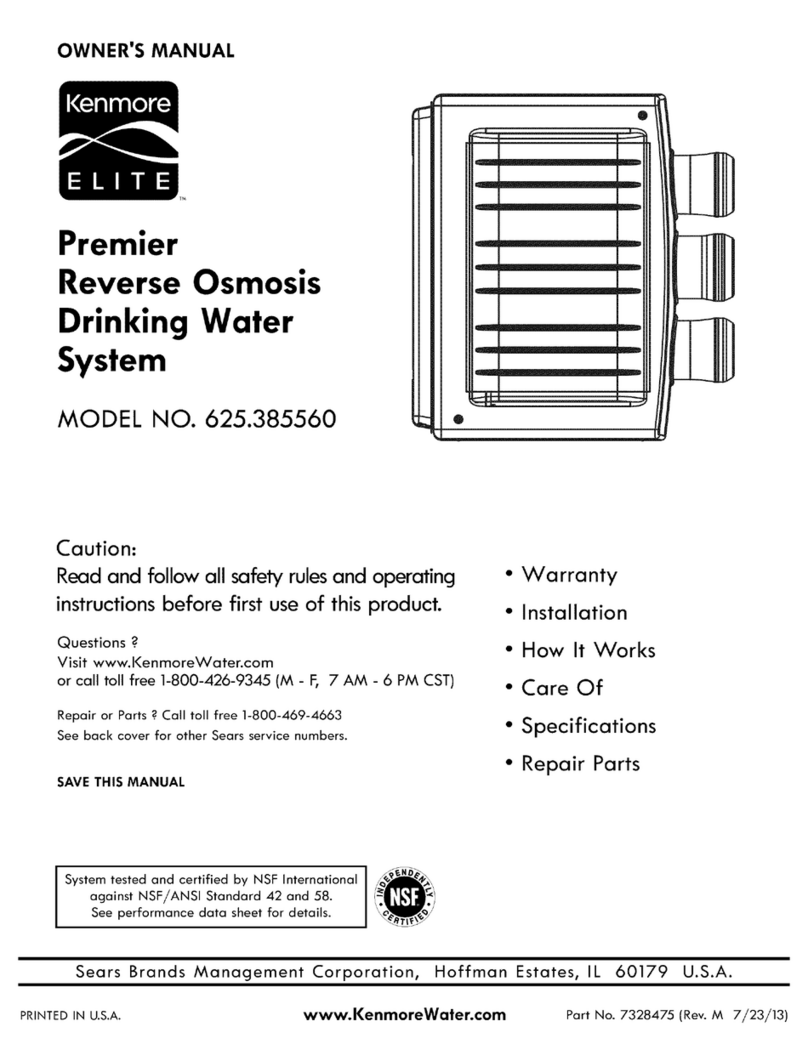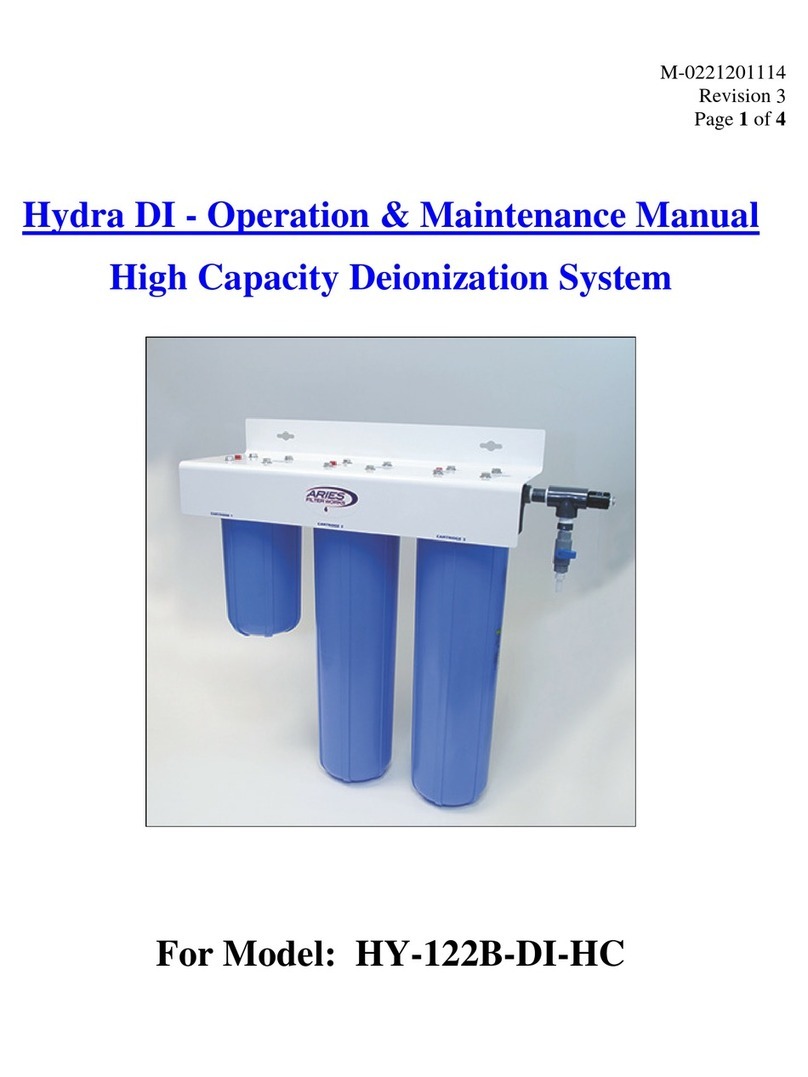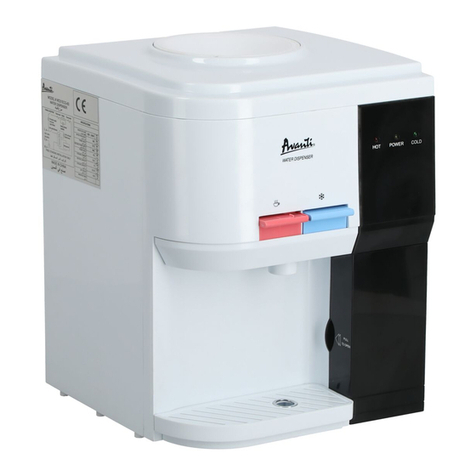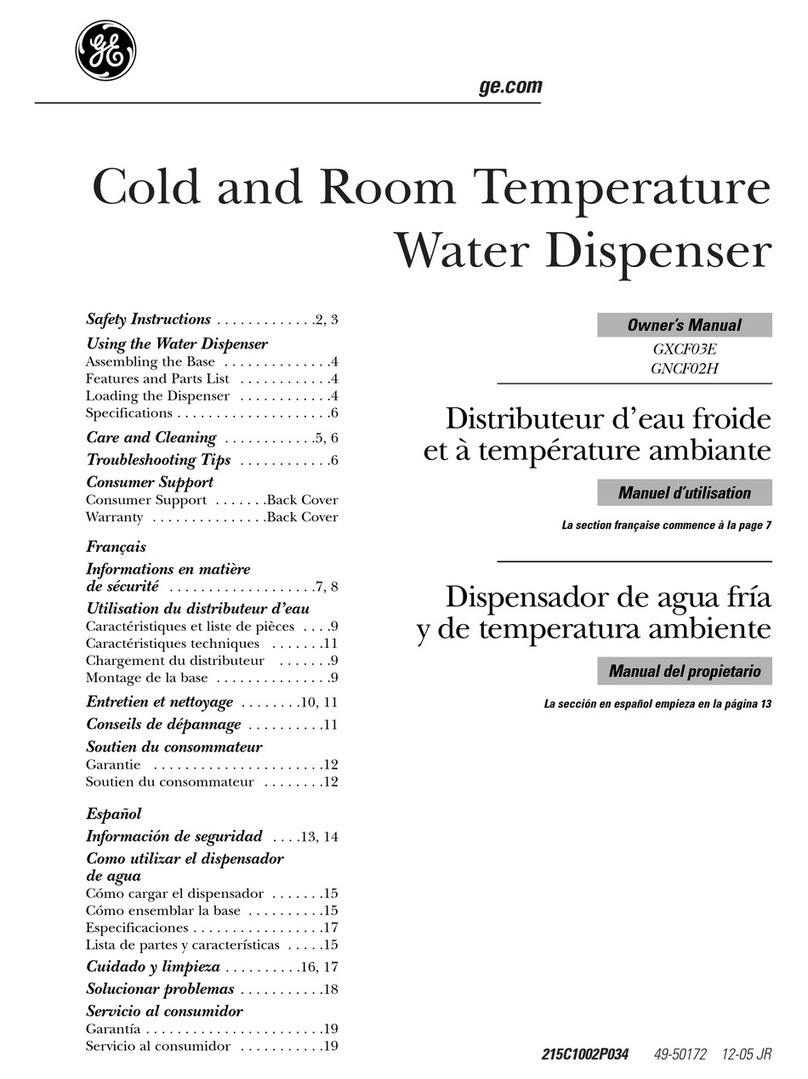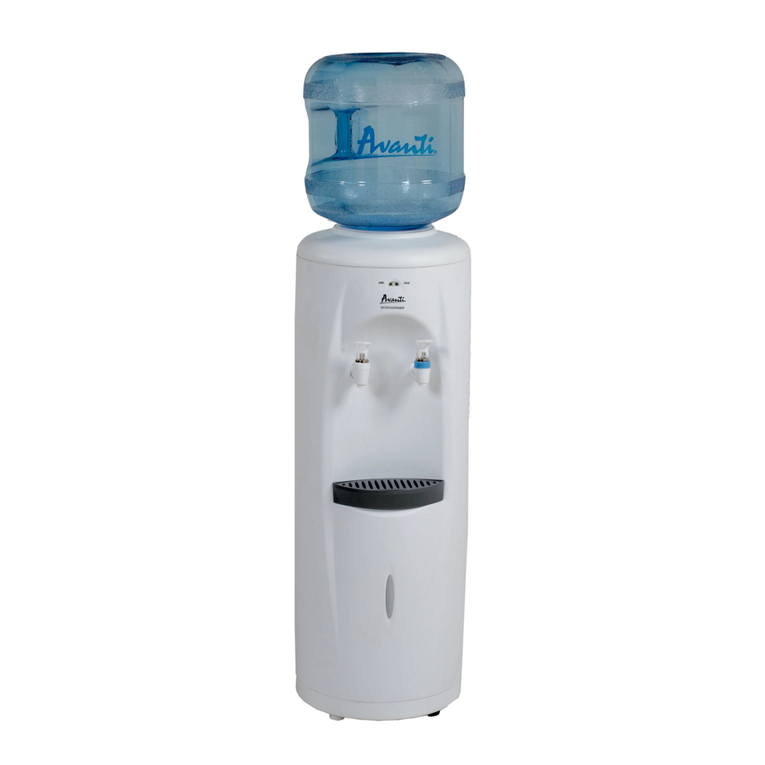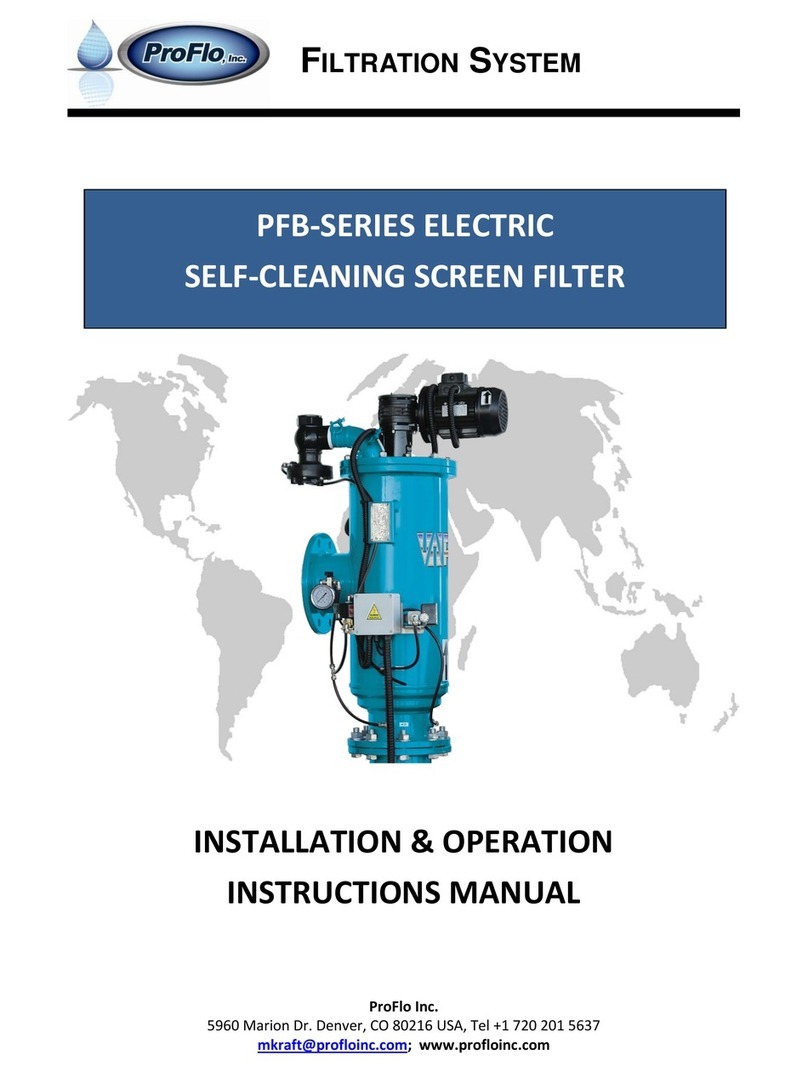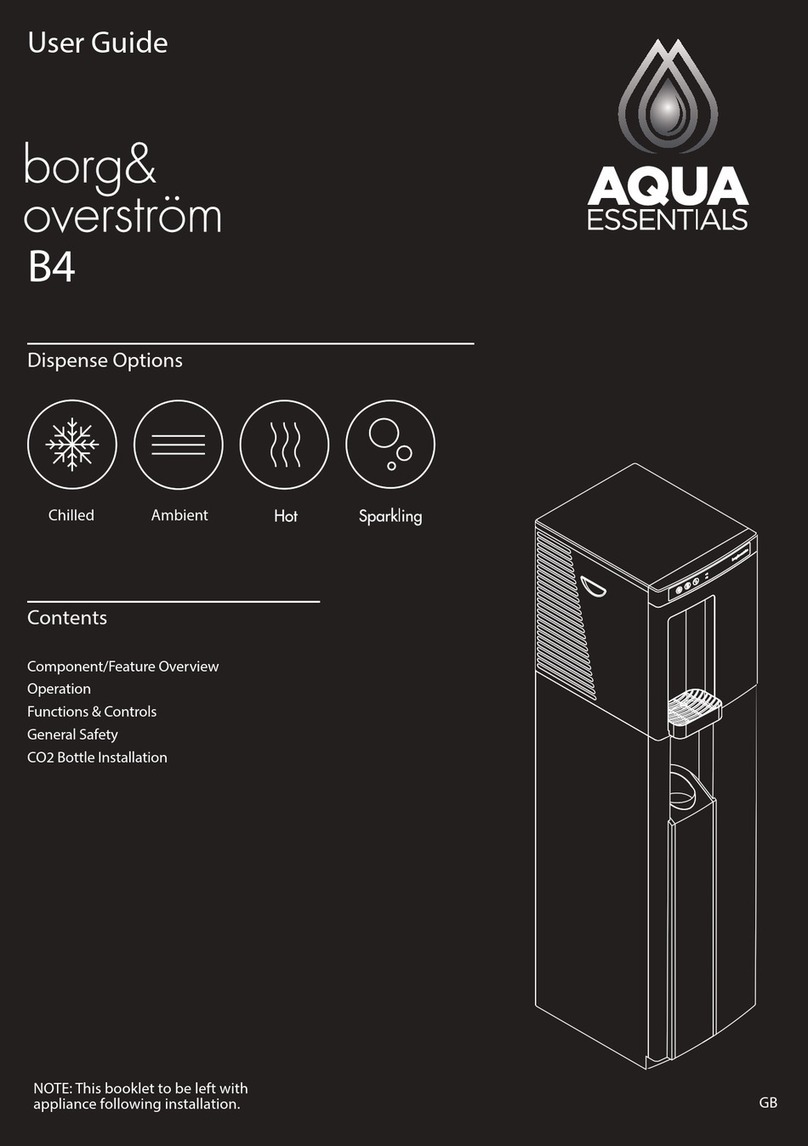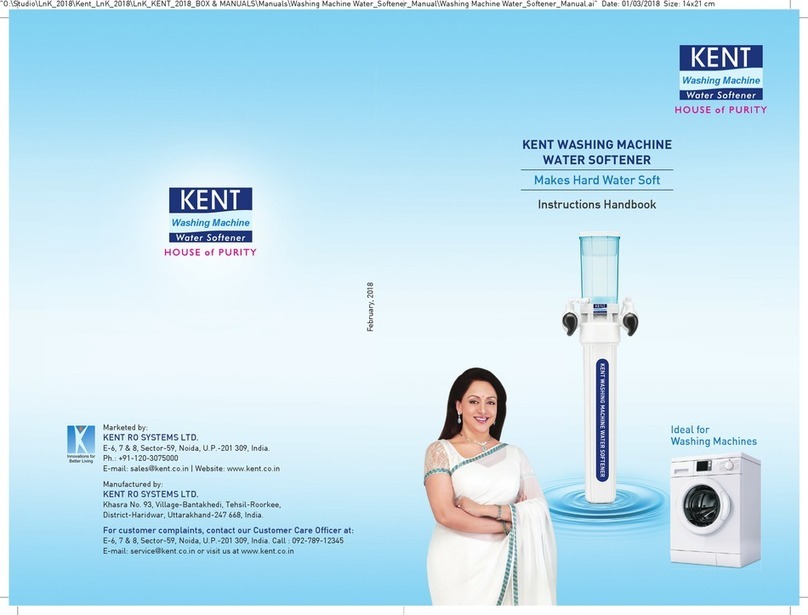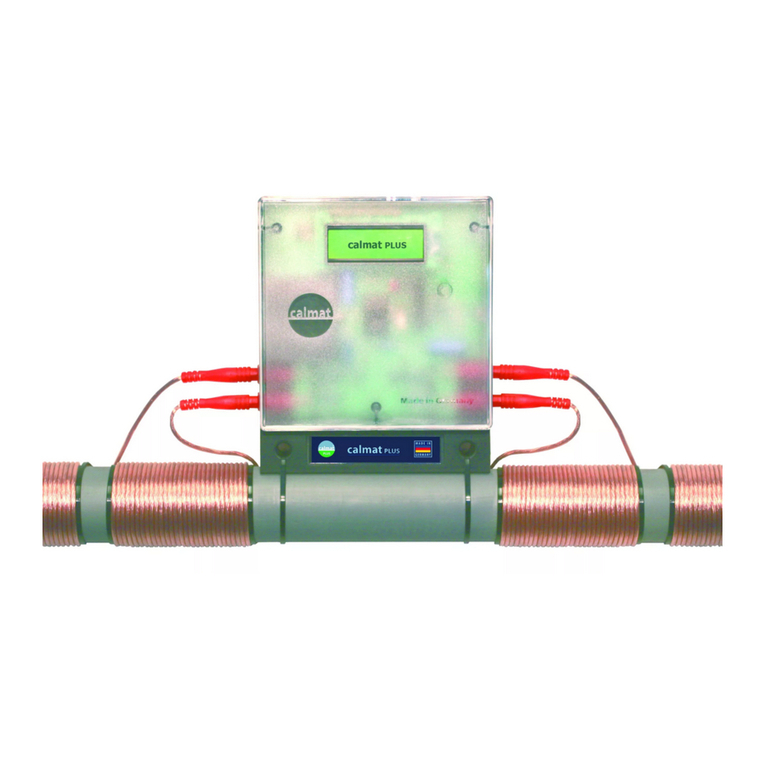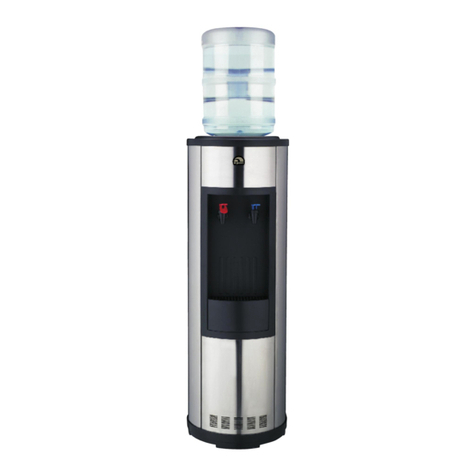Eco Pure EPHY User manual

7370008 (Rev. C 8/6/18)
How to install, operate and
maintain your Whole Home
Water Treatment System
Manufactured and warranted by
Ecodyne Water Systems
1890 Woodlane rive
Woodbury, MN 55125
If you have any questions or concerns when
installing, operating or maintaining your water
treatment system, call our toll free number:
1-800-693-1138
or visit www.ecopure.com
When you call, please be prepared to provide
the model and serial number of your product,
found on the rating decal, located on the rim
below the salt lid hinges.
System tested and certified by the
Water Quality Association against CSA B483.1.
Model EPHY
System tested and certified by NSF International
against NSF/ANSI Standard 42 for the reduction
of chlorine taste and odor, and Standard 44
for hardness reduction, efficiency and the
reduction of barium and radium 226/228,
and certified to NSF/ANSI Standard 372.
Installation and O eration Manual
PRODUCT AND WARRANTY
REGISTRATION
Register your product
online to validate and
extend your warranty.
See warranty page for
details.
www.ecopure.com

2
TABLE OF CONTENTS
Page
Specifications & Performance Claims . . . . . . . . . . . . . . . . . . . . . . . . . . . . . . . . . . . . . . . . . . . . . . . . . . . . . . . . . . 2-3
imensions . . . . . . . . . . . . . . . . . . . . . . . . . . . . . . . . . . . . . . . . . . . . . . . . . . . . . . . . . . . . . . . . . . . . . . . . . . . . . . . . 4
Safety Guides . . . . . . . . . . . . . . . . . . . . . . . . . . . . . . . . . . . . . . . . . . . . . . . . . . . . . . . . . . . . . . . . . . . . . . . . . . . . . . 4
Inspect Shipment . . . . . . . . . . . . . . . . . . . . . . . . . . . . . . . . . . . . . . . . . . . . . . . . . . . . . . . . . . . . . . . . . . . . . . . . . . . . 5
Water Treatment Information . . . . . . . . . . . . . . . . . . . . . . . . . . . . . . . . . . . . . . . . . . . . . . . . . . . . . . . . . . . . . . . . . . . 5
Installation Requirements . . . . . . . . . . . . . . . . . . . . . . . . . . . . . . . . . . . . . . . . . . . . . . . . . . . . . . . . . . . . . . . . . . . . 6-7
Installation Instructions . . . . . . . . . . . . . . . . . . . . . . . . . . . . . . . . . . . . . . . . . . . . . . . . . . . . . . . . . . . . . . . . . . . . 8-11
Programming the Water Treatment System . . . . . . . . . . . . . . . . . . . . . . . . . . . . . . . . . . . . . . . . . . . . . . . . . . . . 12-14
Customizing Features / Options . . . . . . . . . . . . . . . . . . . . . . . . . . . . . . . . . . . . . . . . . . . . . . . . . . . . . . . . . . . . . 15-17
Routine Maintenance . . . . . . . . . . . . . . . . . . . . . . . . . . . . . . . . . . . . . . . . . . . . . . . . . . . . . . . . . . . . . . . . . . . . . 17-18
Troubleshooting . . . . . . . . . . . . . . . . . . . . . . . . . . . . . . . . . . . . . . . . . . . . . . . . . . . . . . . . . . . . . . . . . . . . . . . . . 19-21
Exploded View & Parts List . . . . . . . . . . . . . . . . . . . . . . . . . . . . . . . . . . . . . . . . . . . . . . . . . . . . . . . . . . . . . . . . 22-25
Warranty . . . . . . . . . . . . . . . . . . . . . . . . . . . . . . . . . . . . . . . . . . . . . . . . . . . . . . . . . . . . . . . . . . . . . . . . . . . . . . . . . 26
S ecifications & Performance Claims
This model is efficiency rated. The efficiency rating is valid only at the minimum salt dose. This system has a
demand initiated regeneration ( .I.R.) feature that complies with specific performance specifications intended to min-
imize the amount of regenerant brine and water used in their operation.
This water treatment system has a rated softener efficiency of not less than 3,350 grains of total hardness exchange
per pound of salt (based on sodium chloride) and shall not deliver more salt than its listed rating or be operated at a
sustained maximum service flow rate greater than its listed rating. This system has been proven to deliver soft
water for at least ten continuous minutes at the rated service flow rate. The rated salt efficiency is measured by lab-
oratory tests described in NSF/ANSI Standard 44. These tests represent the maximum possible efficiency that the
system can achieve. Operational efficiency is the actual efficiency after the system has been installed. It is typically
less than the rated efficiency, due to individual application factors including water hardness, water usage, and other
contaminants that reduce a softener's capacity.
While testing was performed under standard laboratory conditions, actual performance of the system may vary based
on local water conditions. This system has been tested according to NSF/ANSI Standard 42 for the reduction of chlorine
taste and odor. The concentration of the indicated substance in water entering the system was reduced to a concentra-
tion less than or equal to the permissible limit for water leaving the system, as specified in NSF/ANSI Standard 42.
continued on next page

3
*Capacity to reduce clear water iron is substantiated by laboratory test data. State of Wisconsin
requires additional treatment if water supply contains clear water iron exceeding 5 ppm.
**Typical residential chlorine concentration is 0.5 to 1.0 ppm.
§ From independent laboratory test data.
This system conforms to NSF/ANSI Standards 42 & 44 for the specific performance claims as
verified and substantiated by test data.
Variable Salt Dose: The salt dose is selected by the electronic controls at regeneration time
based on the amount needed.
SPECIFICATIONS
Model EPHY
Model Code EPHy
Rated Softening Capacity (Grains @ Salt ose)
12,300 @ 2.9 lbs. (1.3 kg)
23,800 @ 9.2 lbs. (4.2 kg)
27,200 @ 15.0 lbs. (6.8 kg)
Rated Efficiency (Grains/Pound of Salt @ Minimum Salt ose) 4,395 @ 2.9 lbs. (1.3 kg)
Water Used uring Regeneration @ Minimum Salt ose 5 gallons (18.9 liters) / 1,000 grains
Total Water Used Per Regeneration @ Maximum Salt ose 50.3 gallons (190 liters)
Rated Service Flow Rate 6.5 gpm (24.6 lpm)
Amount of High Capacity Ion Exchange Resin 0.94 cu. ft. (26.6 liters)
Pressure rop at Rated Service Flow 12.8 psig
Water Supply Max. Hardness 95 gpg
Water Supply Max. Clear Water Iron 3 ppm*
Water Pressure Limits (min. / max.) 20 - 100 psi (1.4 - 7.0 kg/cm2)
Water Temperature Limits (min. / max.) 40 - 100 °F (5 - 38 °C)
Minimum Water Supply Flow Rate 3 gpm (11.4 lpm)
Maximum rain Flow Rate 2 gpm (7.6 lpm)
0.50 ppm
0.75 ppm
Rated Capacity at Chlorine Concentration** of: 1.0 ppm
1.5 ppm
2.0 ppm
2,280,000 gal. (8,630,000 liters)§
1,520,000 gal. (5,750,000 liters)§
1,140,000 gal. (4,310,000 liters)§
760,000 gal. (2,870,000 liters)§
570,000 gal. (2,150,000 liters)§
S ecifications & Performance Claims
PERFORMANCE CLAIMS
Contaminant Influent Challenge Level Maxiumum Allowable
Product Water Level
Barium 10 ±10% mg/L 2.0 mg/L
Radium 226/228 25 pCi/L 5 pCi/L
Substance Influent Challenge Level Reduction Requirement
Chlorine 2.0 ±10% mg/L 50%
Questions? Call Toll Free 1-800-693-1138 or visit www.ecopure.com
When you call, please be prepared to provide the model and serial number,
found on the rating decal, typically located on the rim below the salt lid hinges.

4
Safety Guides
=The water treatment system requires a minimum water flow of 3 gallons (11.4 L) per minute at the inlet.
Maximum allowable inlet water pressure is 100 psi (7.0 kg/cm2). If your house water pressure is over the maxi-
mum, install a pressure reducing valve in the water supply pipe to the system (Adding a pressure reducing valve
may reduce the flow). If your home is equipped with a back flow preventer, an expansion tank must be installed in
accordance with local codes and laws.
=Temperature of the water supply to the softener must be 40-100°F (5-38°C). o not install on hot water.
=The water treatment system works on 24V C electrical power, supplied by a direct plug-in power supply (includ-
ed). Be sure to use the included power supply and plug it into a nominal 120V, 60 Hz household outlet that is in
a dry location only, grounded and properly protected by an overcurrent device such as a circuit breaker or fuse.
=o not use this system to treat water that is microbiologically unsafe or of unknown quality without adequate dis-
infection upstream or downstream of the system.
European irective 2002/96/EC requires all electrical and electronic equipment to be disposed of accord-
ing to Waste Electrical and Electronic Equipment (WEEE) requirements. This directive or similar laws are
in place nationally and can vary from region to region. Please refer to your state and local laws for prop-
er disposal of this equipment.
Do not return the water treatment system to store.
If you have any questions, or there are missing parts or damage, please call Toll Free 1-800-693-1138
or visit www.ecopure.com
When you call, please be prepared to provide the model and serial number, found on the rating decal,
located on the rim below the salt lid hinges.
Dimensions
52.4 cm
8.6 cm
OUT
IN
43.8 cm
TOP VIEW
SI E VIEW FRONT VIEW
108.6 cm
94.0 cm
IN - OUT
FIG. 1

5
Ins ect Shi ment
Water Treatment Information
IRON
Iron in water can cause stains on clothing and plumb-
ing fixtures. It can negatively affect the taste of food,
drinking water, and other beverages. Iron in water is
measured in parts per million (ppm). The total* ppm of
iron, and type or types*, is determined by chemical
analysis. Four different types of iron in water are:
=Ferrous (clear water) iron
=Ferric (red water) iron
=Bacterial and organically bound iron
=Colloidal and inorganically bound iron (ferrous or
ferric)
Ferrous (clear water) iron is soluble and dissolves in
water. This water treatment system will reduce moder-
ate amounts of this type of iron (see specifications).**
Ferrous (clear water) iron is usually detected by taking
a sample of water in a clear bottle or glass.
Immediately after taking, the sample is clear. As the
water sample stands, it gradually clouds and turns
slightly yellow or brown as air oxidizes the iron. This
usually occurs in 15 to 30 minutes.
When using the system to reduce Ferrous (clear
water) iron, add 5 grains to the hardness setting for
every 1 ppm of Ferrous (clear water) iron. See "Set
Water Hardness Number" section.
Ferric (red water), and bacterial and organically bound
irons are insoluble. This water treatment system will
not remove ferric or bacterial iron. This iron is visible
immediately when drawn from a faucet because it has
oxidized before reaching the home. It appears as
small cloudy yellow, orange, or reddish suspended
particles. After the water stands for a period of time,
the particles settle to the bottom of the container.
Generally these irons are removed from water by filtra-
tion. Chlorination is also recommended for bacterial
iron.
Colloidal and inorganically bound iron is of ferric or fer-
rous form that will not filter or exchange out of water.
This water treatment system will not remove colloidal
iron. In some instances, treatment may improve col-
loidal iron water. Colloidal iron water usually has a
yellow appearance when drawn. After standing for
several hours, the color persists and the iron does not
settle, but remains suspended in the water.
SEDIMENT
Sediment is fine, foreign material particles suspended
in water. This water treatment system will not remove
sediment. This material is most often clay or silt.
Extreme amounts of sediment may give the water a
cloudy appearance. A sediment filter installed up -
stream of the system normally corrects this situation.
* Water may contain one or more of the four types of
iron and any combination of these. Total iron is the
sum of the contents.
** Capacity to reduce clear water iron is substantiated
by laboratory test data.
The parts required to assemble and install the water
treatment system are included with the unit.
Thoroughly check the water treatment system for pos-
sible shipping damage and parts loss. Also inspect
and note any damage to the shipping carton.
Remove and discard (or recycle) all packing materials.
To avoid loss of small parts, we suggest you keep the
small parts in the parts bag until you are ready to use
them.
Packing List
Adaptor Elbow FIG. 2
Hose Clamps Grommet
rain HoseBypass Valve
Clips
(including 1 spare)

6
PLUMBING CODES
All plumbing must be completed in accordance with
national, state and local plumbing codes.
AIR GAP REQUIREMENTS
A drain is needed for regeneration water (See Figure
3). A floor drain, close to the water treatment system,
is preferred. A laundry tub, standpipe, etc. are other
drain options. Secure valve drain hose in place.
Leave an air gap of 4 cm between the end of the hose
and the drain. This gap is needed to prevent backflow
of sewer water into the water treatment system. o
not put the end of the drain hose into the drain.
LAUNDRY TUBSTANDPIPE
4 cm
air gap
FLOOR DRAIN
FIG. 3
4 cm
air gap
rain
Hose
rain
Hose
4 cm
air gap
LOCATION REQUIREMENTS
Consider all of the following when selecting an installa-
tion location for the water treatment system.
=o not locate the water treatment system where
freezing temperatures occur. Temperature of the
water supply to the softener must be 40-100°F
(5-38°C). o not install on hot water. Freezing
temperatures or hot water damage voids the war-
ranty.
=To treat all water in the home, install the water treat-
ment system close to the water supply inlet, and
upstream of all other plumbing connections, except
outside water pipes. Outside faucets should remain
on hard water to avoid wasting treated water and salt.
=A nearby drain is needed to carry away regenera-
tion discharge (drain) water. Use a floor drain,
laundry tub, sump, standpipe, or other options
(check your local codes). See "Air Gap Require -
ments" and "Valve rain Requirements" sections.
=The water treatment system works on 24V C elec-
trical power, supplied by a direct plug-in power supply
(included). Provide nearby a 120V, 60Hz electrical
outlet in accordance with national and local codes.
=Always install the water treatment system between
the water inlet and water heater. Any other installed
water conditioning equipment should be installed
between the water inlet and water treatment system
(See Figure 4 below).
=Avoid installing in direct sunlight. Excessive sun
heat may cause distortion or other damage to non-
metallic parts.
Installation Requirements
THE PROPER ORDER TO INSTALL WATER TREATMENT EQUIPMENT
rain
Hose
FIG. 4
Pressure
Tank
City Water Supply
Well Water Supply
Well
Pump
OR
Optional
Sediment
Filter
Water
Heater
Whole Home
Water
Treatment
System
Untreated Water to
Outside Faucets
Hot Water
to House
Cold Water
to House

7
Installation Requirements
VALVE DRAIN REQUIREMENTS
Using the flexible drain hose (included), measure and
cut to the length needed. Flexible drain hose is not
allowed in all localities (check your plumbing codes). If
local codes do not allow use of a flexible drain hose, a
rigid valve drain run must be used. Purchase a com-
pression fitting (1/4 NPT x 1.25 cm minimum tube) and
1.25 cm tubing from your local hardware store. Plumb
a rigid drain as needed (See Figure 6).
NOTE: Avoid drain hose runs longer than 9 meters.
Avoid elevating the hose more than 2.5 meters
above the floor. Make the valve drain line as
short and direct as possible.
FIG. 6
Clip
Barbs
1/4 NPT
Threads
1.25 cm Outside
ia. Copper Tube
(not included)
Compression Fitting.
1/4 NPT x 1.25 cm O. .
Tube (not included)
Cut barbs from drain fit-
ting (pull clip to remove
fitting from valve)
FIG. 7
FIG. 8
SINGLE BYPASS VALVE
Pull out for “Service”
(Treated water)
Push in for
“Bypass”
3 VALVE BYPASS
From Water
Treatment
System
To Water
Treatment
System
Inlet
Valve
Outlet
Valve
Bypass
Valve
FIG. 5
1/4” NPT
Thread Barbs for 9.5 mm
I. . Tubing
rain Hose
Hose Clamp
INLET / OUTLET PLUMBING OPTIONS
Always install either a single bypass valve (provided),
as shown in Figure 7, or, if desired, parts for a 3 valve
bypass system (not included) can be purchased and
assembled, as shown in Figure 8. Bypass valves
allow you to turn off water to the softener for mainte-
nance if needed, but still have water in house pipes.
Use:
=Copper pipe
=Threaded pipe
=PEX (Crosslinked Polyethylene) pipe
=CPVC plastic pipe
=Other pipe approved for use with potable water
IMPORTANT: o not solder with plumbing attached to
the single bypass valve. Soldering heat
will damage the plastic valve.

8
Installation Instructions
TURN OFF WATER SUPPLY
1. Close the main water supply valve, located near the
well pump or water meter.
2. Shut off the electric or fuel supply to the water
heater.
3. Open all faucets to drain all water from house pipes.
NOTE: Be sure not to drain water from the water
heater, as damage to the water heater ele-
ments could result.
ASSEMBLY
1. EcoPure models are factory assembled. uring
installation, unsnap and remove the top cover,
together with the salt lid, to expose the water treat-
ment system valve assembly. Set them aside to
prevent damage. Check the brinewell to be sure it
is secured and vertical (See Figure 13).
2. Lift the brine valve out of the brinewell. Make sure
the float stem is parallel to the stand tube so the
seals will seat properly during operation. Place the
brine valve back into the bottom of the brinewell and
reinstall the brinewell cover.
3. Install the brine tank overflow grommet and elbow
into the 2 cm diameter hole in the back of the salt
storage tank wall.
MOVE THE SYSTEM INTO PLACE
1. Move the water treatment system into the desired
location. Set it on a solid, level surface.
IMPORTANT: o not place shims directly under the
salt storage tank to level the system.
The weight of the tank, when full of
water and salt, may cause the tank to
fracture at the shim.
2. Visually check and remove any debris from the
water treatment system valve inlet and outlet ports.
3. Make sure the turbine assembly spins freely in the
"out" port of the valve (See Figure 10).
4. If not already done, put a light coating of silicone
grease on the single bypass valve o-rings.
5. Push the single bypass valve into the system valve
as far as it will go. Snap the two large holding clips
into place, from the top down as shown in Figures
11 & 12.
IMPORTANT: Be sure the clips snap firmly into place
so the single bypass valve will not pull
out.
FIG. 9
To Outside
Faucets
Conditioned
Water
Hard Water
Main Water Pipe
Valve rain
Elbow
Valve rain
Hose*
* o not connect
the water softener
valve drain hose
to the salt storage
tank overflow
hose. Floor rain
Overflow
rain Elbow
Salt Storage
Tank Overflow
Hose*
Secure Valve rain Hose
in place over Floor rain
NOTE: See “Air Gap Requirements” section.
1-1/2”
air gap
Typical Installation
Plug-in
Power
Supply
Water Softener
Valve
To
Controller
Inlet
Outlet
Clips
Pipes
1” NPT Sweat
Adaptors (not
included)
Single
Bypass Valve
Lubricated
O-rings

9
Installation Instructions
FIG. 13
Top Cover
Brine Tank
Overflow
Elbow
Brine Tank
Overflow
Grommet
2 cm Hole
Salt Lid
Salt
Storage
Tank
Float
Stem
Brine
Tubing
Brinewell
Cover
Stand
Tube
Brine
Valve
Brinewell
Nozzle & Venturi
Assembly
FIG. 10
Turbine Turbine Support Assembly
Valve Outlet
FIG. 11
Clip
Channel
Single Bypass Valve
FIG. 12
Correct Assembly
Clip
Outside diameter
of clip channel on
single bypass valve
Outside diameter of
water treatment sys-
tem valve inlet & outlet
NOTE: Be sure all 3 tabs of the clip go through the matching
holes on the water treatment system valve inlet or
outlet, and fully into the channel on the single bypass
valve. Make sure that the tabs are fully seated.
COMPLETE INLET AND OUTLET PLUMBING
Measure, cut, and loosely assemble pipe and fittings
from the main water pipe to the inlet and outlet ports of
the water treatment system valve. Be sure to keep fit-
tings fully together, and pipes squared and straight.
Be sure hard water supply pipe goes to the water
treatment system valve inlet side.
NOTE: Inlet and outlet are marked on the water treat-
ment system valve. Trace the water flow direc-
tion to be sure hard water is to inlet.
IMPORTANT: Be sure to fit, align and support all
plumbing to prevent putting stress on
the water treatment system valve inlet
and outlet. Undue stress from mis-
aligned or unsupported plumbing may
cause damage to the valve.
Complete the inlet and outlet plumbing for the type of
pipes you will be using.
COLD WATER PIPE GROUNDING
CAUTION: The house cold water pipe (metal only)
is often used as a ground for the house
electrical system, The 3-valve bypass
type of installation, shown in Figure 8,
will maintain ground continuity. If you
use a plastic bypass valve at the unit,
continuity is broken. To restore the
ground, do the following:
1. Install a #4 copper wire across the removed section
of main water pipe, securely clamping it at both
ends (See Figure 14) - parts not included.
NOTE: Check local plumbing and electrical codes
for proper installation of the ground wire.
The installation must conform to them. In
Massachusetts, plumbing codes of
Massachusetts shall be conformed to.
Consult with your licensed plumber.
FIG. 14
Ground Wire
Clamp (2)

10
Installation Instructions
INSTALL VALVE DRAIN HOSE
NOTE: See valve drain options on pages 6 & 7.
1. Measure, cut to needed length and connect the 9.5
mm drain line (provided) to the water treatment sys-
tem valve drain fitting. Use a hose clamp to hold
the hose in place.
IMPORTANT: If codes require a rigid drain line see
“Valve rain requirements" section.
2. Run the drain hose (or a rigid line) to the floor drain.
Secure drain hose. This will prevent “whipping'' dur-
ing regenerations. Be sure to provide a 4 cm min-
imum air gap to prevent possible sewer water
backup. See “Air Gap Requirements" section.
NOTE: In addition to a floor drain, you can use a laun-
dry tub or standpipe as a good drain point for
this hose.. Avoid long drain hose runs, or ele-
vating the hose more than 2.5 meters above
the floor.
INSTALL SALT STORAGE TAN OVERFLOW
HOSE
1. Measure, cut to needed length and connect the 9.5
mm drain line (provided) to the salt storage tank
overflow elbow and secure in place with a hose
clamp.
2Route the hose to the floor drain, or other suitable
drain point no higher than the drain fitting on the salt
storage tank (This is a gravity drain). If the tank
overfills with water, the excess water flows to the
drain point. Cut the drain line to the desired length
and route it neatly out of the way.
IMPORTANT: For proper operation of the water treat-
ment system, do not connect the system
valve drain tubing to the salt storage
tank overflow hose.
ADD WATER AND SALT TO THE SALT
STOR AGE TAN
1. Using a container, add about three gallons of clean
water into the salt storage tank.
2. Add salt to the storage tank. Use nugget, pellet or
coarse solar salts with less than 1% impurities.
PLUG IN THE POWER SUPPLY
uring installation, the water treatment system wiring
may be moved or jostled from place. Check to be sure
all leadwire connectors are secure on the back of the
electronic board and be sure all wiring is away from
the valve gear and motor area, which rotates during
regenerations.
1. Plug the water softener’s power supply into an elec-
trical outlet that is not controlled by a switch and is
approved by local codes.
NOTE: The water heater is filled with hard water and,
as hot water is used, it will refill with treated
water. In a few days, the hot water will be fully
treated. To have fully treated hot water imme-
diately, wait until the initial recharge is over.
Then, drain the water heater (following instruc-
tions for water heater) until water runs cold.
PROGRAM THE CONTROLLER
1. Install the system’s top cover and salt lid.
2. Complete the programming steps on pages 12 & 13.
RINSE OUT CARBON FINES
Small particles of carbon filtration material are generat-
ed during manufacturing and shipping, which will exit
the media tank with the first water flow. These carbon
“fines” are not harmful, but give the water a gray color
and should be rinsed down the drain before any water
from the system is directed to the home’s faucets or
water heater.
CAUTION: To avoid water or air pressure damage to
system inner parts, and to flush pipe chips
or other residue from the water pipes, be
sure to do the following steps exactly as
instructed.
1. Make sure the water treatment system’s valve drain
hose is hooked up and the open end directed to a
floor drain, laundry tub or other suitable type of
drain.
2. The system should be connected to electrical power.
3. Place bypass valve(s) in “bypass” position (see
Figures 7 & 8). On a single valve, slide the stem
inward to bypass. On a 3-valve bypass, close the
inlet and outlet valves and open the bypass valve.
4. Fully open the house main water pipe shutoff valve.
5. Initiate a regeneration by pressing and holding for 3
seconds the RECHARGE button (see Figure 16 on
page 12). The valve motor will start running and the
valve will advance to the “Fill” position.
6. After you hear the valve motor stop running (valve
in “Fill” position), press, but do not hold, the
RECHARGE button. The valve will advance to the
“Brine” position.
continued on next page

11
Installation Instructions
FIG. 15
...depressurize the
plumbing, then push By -
pass Valve body toward
water treatment system
If removing
clips...
7. After you hear the valve motor stop running (valve
in “Brine” position), press, but do not hold, the
RECHARGE button. The valve will advance to the
“Backwash” position.
8. Once the unit is in backwash, place bypass valve(s)
in SERVICE, EXACTLY as follows:
a. Single Bypass Valve: Slowly, slide pull the valve
stem outward toward service, pausing several times
to allow the system to pressurize gradually.
b. 3-Valve Bypass: Fully close the bypass valve and
open the outlet valve. Slowly open the inlet valve,
pausing several times to allow the system to pres-
surize gradually.
9. Let the water treatment system complete the back-
wash and fast rinse cycles (takes about 20 min-
utes). When the regeneration ends, the system’s
valve returns to the service position.
SANITIZE THE WATER SOFTENER /
SANITIZE AFTER SERVICE
Care is taken at the factory to keep your unit clean and
sanitary. Materials used to make the unit will not infect
or contaminate your water supply, and will not cause
bacteria to form or grow. However, during shipping,
storage, installation and operation, bacteria could get
into the unit. For this reason, sanitizing as follows is
suggested* when installing.
1. Slide open the salt lid, remove the brinewell cover
and pour about 90 ml (6 tablespoons) of household
bleach into the softener brinewell. Replace the
brinewell cover.
2Make sure the bypass valve(s) is in the “service”
(open) position.
3 Start a recharge: Press the RECHARGE button and
hold for 3 seconds, until “Recharge Now” begins to
flash in the display. This recharge draws the sanitiz-
ing bleach into and through the water softener. Any
air remaining in the unit is purged to the drain.
4. After the recharge has completed, fully open a cold
water faucet, downstream from the softener, and
allow 190 liters of water to pass through the system.
This should take at least 20 minutes. Close the
faucet.
*Recommended by the Water Quality Association. On some
water supplies, the unit may need periodic disinfecting.
RESTART THE WATER HEATER
1. Turn on the electricity or fuel supply to the water
heater and relight the pilot, if applicable.
NOTE: The water heater is filled with hard water and,
as hot water is used, it refills with treated
water. In a few days, the hot water will be fully
treated. To have fully treated hot water imme-
diately, wait until the initial recharge (previous
step) is over. Then, drain the water heater (fol-
lowing instructions for water heater) until water
runs cold.
TEST FOR LEA S
To check for leaks, complete the following steps:
1. Fully open two nearby cold water faucets down-
stream from the water treatment system.
2. Observe steady water flow from both open faucets.
3After about three minutes, open a hot water faucet
for about one minute, or until all air is expelled, then
close.
4. Close both cold water faucets.
5. Check your plumbing work for leaks, and fix right
away if any are found. Be sure to observe previous
caution notes.
NOTE: If this procedure is performed on a new sys-
tem, water coming from the taps may initially
be discolored. This normally occurs the first
time water runs through the resin bed. The
discolored water is not harmful, and the discol-
oration will not last more than a few minutes.
Questions? Call Toll Free 1-800-693-1138 or visit www.ecopure.com
When you call, please be prepared to provide the model and serial number,
found on the rating decal, typically located on the rim below the salt lid hinges.

12
FIG. 17
FIG. 16
Low Salt LE Indicator
isplay
SELECT button OWN button
RECHARGE button
UP button
PROGRAM THE SYSTEM
When the power supply is plugged into the electrical
outlet, the model code and a software version number
(example: J3.9), are briefly shown in the display.
Then the words “PRESENT TIME” appear and “12:00
PM” begins to flash.
NOTE: If “- - - -” shows in the display, press the
p
UP
or
q
OWN button until the model code
(“EPHy” for Model EPHY) shows in the dis-
play. Then, press the SELECT button to set,
and change to the flashing “SET TIME" display.
SET TIME OF DAY
If the words “SET TIME" do not show in the display,
press the SELECT button until they do.
1. Press the
p
UP or
q
OWN buttons to set the
present time. Up moves the display ahead; down
sets the time back. Be sure AM or PM is correct.
LOW SALT LIGHT / CLEAN REMINDER
When the water treatment system is connected to
electrical power, the light on the control panel will
operate as follows:
=Light flashing, with the time of day shown in
the display - The salt monitor system indicates a
low salt level and needs to be set. See “Set Salt
Level” on Page 13.
=Light flashing, with “CLEAn” flashing in the
display (See Fig. 17) - Four months have elapsed
on the system’s timer since start up or the last
reset.
This is a reminder to use EcoPure EPCL Water
Softener Cleaner three times a year.
P/N 7346596 ●orders.ecodyne.org
To reset the timer, press any button on the control
panel and “CLEAn” will disappear. The light will
stop flashing, unless the system is also low on salt
(see above).
FIG. 18
NOTE: Press buttons and quickly release to slowly
advance the display. Hold the buttons down
for fast advance.
continued on next page
Programming the Water Treatment System
Questions? Call Toll Free 1-800-693-1138 or visit www.ecopure.com
When you call, please be prepared to provide the model and serial number,
found on the rating decal, typically located on the rim below the salt lid hinges.

13
Programming the Water Treatment System
FIG. 19
SET WATER HARDNESS NUMBER
1. Press the SELECT button once again to display a
flashing “25” and the word “HAR NESS”.
2. Press the
p
UP or
q
OWN buttons to set your
water’s hardness number.
NOTE: If your water supply contains iron, compen-
sate for it by adding to the water hardness
number. For example, assume your water is
20 gpg hard and contains 2 ppm iron. Add 5
to the hardness number for each 1 ppm of
iron. In this example, you would use 30 for
your hardness number.
20 gpg hardness
2 ppm iron x 5 = 10 +10
(times) 30 HAR NESS NUMBER
NOTE: If you use potassium chloride (KCl) salt
instead of sodium chloride (NaCl) salt in this
softener, increase the hardness setting by
25%. For example, if you will be using KCl
and your water supply’s hardness is 20 gpg,
set the softener to 25 gpg.
SET RECHARGE (REGENERATION) TIME
Your demand water treatment system will automati-
cally regenerate when it needs to, based on water
usage. The time of day that the automatic recharge
cycle begins may be changed as follows:
1. Press the SELECT button once again to display a
flashing “2:00AM” and the words “SET RECHARGE
TIME”. This is a good time for the recharge to start
in most households, because water is not in use.
FIG. 20
SET SALT LEVEL
The water treatment system has a low salt indicator
light to remind you to refill the storage tank with salt.
NOTE: You must set salt level each time salt is added
to the water softener.
To set this monitor system:
1. Lift the salt lid and level the salt in the storage tank.
2. The salt level scale, on the brinewell inside the
tank, has numbers from 0 to 8 (See Fig. 21).
Observe the highest number the leveled salt is at,
or closest to.
3. Press the SELECT button to display the words
“SET SALT LEVEL”.
4. Press the
p
UP or
q
OWN buttons until the num-
ber on the screen corresponds to the salt level. At
level 2 or below, the “Low Salt" indicator light will
flash. If you wish to turn this feature off, press the
q
OWN button past 0, and the word “OFF” flash-
es in the display.
5. Press the SELECT button once more to complete
the initial programming. The current time of day
will show in the display.
2. If you want to change the recharge start time,
press the
p
UP or
q
OWN buttons until the
desired time shows. Be sure AM or PM is correct.
FIG. 21
LEVEL
SALT
Salt
Level
Brine-
well
Num -
bers

14
RECHARGE NOW
At times of greater than normal water use, such as
when you have guests, you could run out of treated
water before the next scheduled recharge. If this
happens, you may want to initiate an immediate
regeneration, as follows:
1. Press and hold the RECHARGE button until the
words “RECHARGE NOW" flash in the display.
The system enters the fill cycle of regeneration right
away. “RECHARGE NOW” will flash during the
regeneration. When completed (in about 2 hours),
full water treatment capacity is restored.
NOTE: Avoid using hot water while the system is
regenerating, because the water heater will
refill with bypass hard water.
RECHARGE TONIGHT
If you do not want to start an immediate recharge, but
would like an extra recharge at the next preset
recharge time, do the following to schedule a
recharge:
1. Press and release (do not hold) the RECHARGE
button.
The words “RECHARGE TONIGHT" flash in the dis-
play, and the water treatment system will recharge at
the next preset recharge time (If you decide to cancel
the regeneration before it begins, press and release
the RECHARGE button once more, and “RECHARGE
TONIGHT” will disappear from the display). uring
regeneration, the word “RECHARGE NOW" will flash
in the screen. When completed, full water treatment
capacity is restored.
RECHARGE NOW initiated
FIG. 22
RECHARGE TONIGHT initiated
FIG. 23
Programming the Water Treatment System

Customizing Features / O tions
FIG. 29
FIG. 28
FIG. 27
CLEAN FEATURE
This feature is beneficial on water supplies containing
iron and/or high amounts of sediments (sand, silt, dirt,
etc.). When set to ON, a backwash and fast rinse
cycle will occur first, preceding the normal regenera-
tion sequence. This provides extra cleaning of the
resin bed before it is regenerated with the salt brine.
To conserve water, if your water supply does not con-
tain iron or sediments, be sure this feature is set to
OFF. The default is OFF.
To change between OFF and ON:
1. Press and hold the SELECT button until the screen
in Figure 27 is displayed.
3. Use the
p
UP or
q
OWN buttons to change
between OFF and ON.
4. When the desired Clean Feature setting appears in
the display, press the SELECT button five times to
return to the normal run (time of day) screen.
CLEAN FEATURE MINUTES
If you have set the Clean Feature ON, the length of
the extra backwash cycle automatically is set to 6
minutes. However, you can ad just this time from 1 to
15 minutes in length.
To change this cycle time:
1. Press and hold the SELECT button until the screen
in Figure 27 is displayed.
2. Press the SELECT button three times to display
the “Set Clean Time“ screen (See Figure 29).
2. Press the SELECT button twice again, so that
“SET CLEAN OFF” or “SET CLEAN ON” flashes in
the display (See Figure 28).
15
SET SALT EFFICIENCY
When this feature is ON, the water softener will oper-
ate at salt efficiencies of 4000 grains of hardness per
pound of salt or higher (May recharge more often
using smaller salt dosage but more regeneration
water). The softener is shipped with this feature set
OFF.
1. Press and hold the SELECT button until one of the
screens in Figure 24 is displayed. Once in this dis-
play, press the SELECT button once again and one
of the two displays in Figure 25 is shown.
2. Press the
p
UP or
q
OWN buttons to set ON or
OFF. When set to ON, the efficiency icon will be
displayed on the right hand side of the normal run
display.
3. Press the SELECT button six times, to return to the
normal run display (See Figure 26).
FIG. 24
FIG. 25
Efficiency Icon
FIG. 26
isplayed when efficiency
is set to “ON”

16
Customizing Features / O tions
3. Use the
p
UP or
q
OWN buttons to change
between “12 hr” and “24 hr”.
4. When the desired setting appears in the display,
press the SELECT button three times to return to
the normal run (time of day) screen.
ADJUSTABLE BAC WASH
If your incoming water supply has higher sediments
or clear water iron, a longer Backwash and/or Fast
Rinse time may help in keeping the unit cleaner.
To change the length of the Backwash:
1. Press and hold the SELECT button until the screen
in Figure 24 is displayed.
2. Press the SELECT button five times, so that “SET
TIME bA” appears in the display (See Figure 31).
3. Press the
p
UP or
q
OWN buttons to set the
length of Backwash in minutes.*
4. When the desired Backwash time appears in the
display, press the SELECT button twice to return to
the normal run (time of day) screen.
* Setting backwash and/or fast rinse times too low
may result in salty tasting water after regeneration.
FIG. 31
3. Use the
p
UP or
q
OWN buttons to set the length
of the clean time in minutes.
4. When the desired clean time appears in the dis-
play, press the SELECT button four times to return
to the normal run (time of day) screen.
12 OR 24 HOUR CLOC
All time displays are shown in standard clock time
(1 to 12 AM; and 1 to 12 PM) at the “12 hr” default
setting.
To change this setting:
1. Press and hold the SELECT button until the screen
in Figure 24 is displayed.
2. Press the SELECT button four times, so that “12
hr” or “24 hr” flashes in the display (See Figure 30).
FIG. 30
FIG. 32
Top
istributor
Cleansing Screen
Resin
Tank
FIG. 33
ADJUSTABLE FAST RINSE
To change the length of the Fast Rinse:
1. Press and hold the SELECT button until the screen
in Figure 27 is displayed.
2. Press the SELECT button six times, so that “SET
TIME Fr” appears in the display (See Figure 32).
3. Press the
p
UP or
q
OWN buttons to set the
length of Fast Rinse in minutes.*
4. When the desired Fast Rinse time appears in the
display, press the SELECT button once to return to
the normal run (time of day) screen.
CLEANSING FEATURE
The cleansing feature keeps larger particles of sedi-
ment from entering the home’s plumbing system. As
water passes through the softener, the larger sedi-
ment particles are collected in the integrated basket
and then rinsed to the drain before each regenera-
tion. The cleansing feature provides added protection
for water using appliances by reducing the chance of
larger particles entering the various products valves
and screens. The “Clean Feature” may be turned ON
to provide an extra backwash that will help keep the
cleansing screen clean. The default is OFF.
IMPORTANT: The cleansing feature is not intended to
replace pretreatment filtration. For
problem water applications, additional
sediment filtration is recommended.

17
Features / O tions
POWER OUTAGE MEMORY
If electrical power to the water treatment system is
lost, “memory'' built into the timer circuitry will keep all
settings for several hours. While the power is out, the
display is blank and the system will not regenerate.
When electrical power is restored, the following will
occur.
You have to reset the present time only if the display
is flashing. The HAR NESS and RECHARGE TIME
never require resetting unless a change is desired.
Even if the clock is incorrect after a long power out-
age, the system operates as it should to keep your
water soft. However, regenerations may occur at the
wrong time of day until you reset the clock to the cor-
rect time of day.
NOTE: If the water treatment system was regenerat-
ing when power was lost, it will now finish the
cycle.
Routine Maintenance
ADDING SALT
Lift the salt lid and check the salt storage level fre-
quently. If the water treatment system uses all the salt
before you refill it, you will experience hard water.
Until you have established a refilling routine, check the
salt every two or three weeks. Always add if less than
1/4 full. Be sure the brinewell cover is on.
NOTE: In humid areas, it is best to keep the salt stor-
age level lower, and to refill more often to
avoid salt “bridging”.
Recommended Salt: Nugget, pellet or coarse solar
salts with less than 1% impurities.
Salt Not Recommended: Rock salt, high in impurities,
block, granulated, table, ice melting, ice cream making
salts, etc.
BREA ING A SALT BRIDGE
Sometimes, a hard crust or salt “bridge” forms in the
brine tank. It is usually caused by high humidity or the
wrong kind of salt. When the salt “bridges,” an empty
space forms between the water and the salt. Then,
salt will not dissolve in the water to make brine.
Without brine, the resin bed is not recharged and hard
water will result.
If the storage tank is full of salt, it is difficult to tell if
you have a salt bridge. A bridge may be underneath
loose salt. Take a broom handle, or like tool, and hold
it next to the water treatment system. Measure the
distance from the floor to the rim of the water treat-
ment system. Then, gently push the broom handle
straight down into the salt. If a hard object is felt
before the pencil mark is even with the top, it is most
likely a salt bridge. Gently push into the bridge in sev-
eral places to break it. o not use any sharp or point-
ed objects as you may puncture the brine tank. o not
try to break the salt bridge by pounding on the outside
of the salt tank. You may damage the tank.
FIG. 34
Broom
Handle
Pencil
Mark
3-5 cm
Salt
Salt
Bridge
Water
Level
Push Tool into
Salt Bridge to
Break

18
Routine Maintenance
Floor rain FIG. 36
Wood Block
FIG. 35
Cap
O-ring Seal
Screen Support
Screen
Gasket
*Flow Plug (HV C)
Housing
Ferrule
Nut
Cone Screen
*Flow Plug
*Install with lettered
side up, concave
side down.
CLEANING THE NOZZLE & VENTURI
A clean nozzle & venturi (See Figure 35) is a necessity
for the water treatment system to work properly. This
small component creates the suction to move brine
from the brine tank, into the resin tank. If it should
become plugged with sand, silt, dirt, etc., the system
will not work, and hard water will result.
Nozzle & Venturi isc
IMPORTANT: Be sure small hole in the gasket is cen-
tered directly over the small hole in the nozzle & ven-
turi housing. Be sure the numbers are facing up.
To get access to the nozzle & venturi, remove the
water treatment system’s top cover. Put the bypass
valve(s) into the bypass position. Be sure the system
is in soft water (service) cycle (no water pressure at
nozzle & venturi). Then, holding the nozzle & venturi
housing with one hand, un screw the cap. o not lose
the o-ring seal. Lift out the screen support and screen.
Then, remove the nozzle & venturi disc, gasket and
flow plug(s). Wash the parts in warm, soapy water
and rinse in fresh water. Be sure to clean both the top
and bottom of the nozzle & venturi disc. If needed,
use a small brush to remove iron or dirt. o not
scratch, misshape, etc., surfaces of the nozzle & ven-
turi.
Gently replace all parts in the correct order. Lubricate
the o-ring seal with silicone grease and locate in place.
Install and tighten the cap by hand, while supporting
the housing. Overtightening may break the cap or
housing. Put the bypass valve(s) into service (soft
water) position.
Recharge the water treatment system to reduce water
level in the tank. This will also assure that the system
is completely recharged and ready to provide softened
water again. Check the water level in the tank by look-
ing down the brinewell. If the water level does not
drop after a recharge, the problem has not been
resolved. Call 1-800-693-1138.
PROTECT THE WATER TREATMENT SYS-
TEM FROM FREEZING
If the water treatment system is installed where it could
freeze (summer cottage, lake home, etc.), you must
drain all water from it to stop possible freeze damage.
To drain the system:
1. Close the shut-off valve on the house main water
pipe, near the water meter or pressure tank.
2. Open a faucet in the treated water pipes to vent
pressure in the system.
3. Move the stem in the single bypass valve to bypass.
Close the inlet and outlet valve in a 3 valve bypass
system, and open the bypass valve. If you want
water in the house pipes again, reopen the shut-off
valve on the main water pipe.
4. Unplug the power supply at the wall outlet. Slide
open the salt lid and remove the water treatment
system’s top cover. Take off both drain hoses if they
will interfere with moving the system into position
over the drain.
5. Carefully remove the large holding clips at the water
treatment system inlet and outlet. Separate the sys-
tem from the plastic installation adaptors, or from
the bypass valve.
6. Lay a piece of 5 cm thick board near the floor drain
(See Figure 36).
7. Move the water treatment system close to the drain.
Slowly and gently, tip it over until the rim rests on
the wood block with the inlet and outlet over the
drain. o not allow the system’s weight to rest on
the inlet and outlet fittings or they may break.
8. Tip the bottom of the water treatment system up a
few centimeters and hold until all water has drained.
Leave the system laying like this until you are ready
to use it. Plug the inlet and outlet with clean rags to
keep dirt, bugs, etc. out.

19
Troubleshooting Guide
PROBLEM CAUSE CORRECTION
No sof wa er 1. No salt in the storage tank. Refill with salt and then use RECHARGE NOW feature.
No sof wa er & dis-
play is blank
1. Power supply unplugged at wall outlet, or
power cable disconnected from back of elec -
tronic board or power supply malfunction.
Check for loss of power and correct. Reset electronic
controls and then use RECHARGE NOW feature.
2. Fuse blown, circuit breaker popped, or cir-
cuit switched off (See “Power Outage
Memory” on Page 17).
Replace fuse, reset circuit breaker, or switch circuit on,
and then use RECHARGE NOW feature.
3. Electronic control board malfunction. Replace electronic control board (See Page 23).
No sof wa er & sal
level no dropping
1. Salt storage tank “bridged”. Refer to “Breaking a Salt Bridge” section to break.
2. Bypass valve(s) in “bypass” position. Move bypass valve(s) to “service” position.
No sof wa er & sal
s orage ank full of
wa er,
wa er running o
drain while uni is in
he sof wa er cycle
1. irty, plugged or damaged nozzle & venturi
assembly
Take apart, clean and inspect nozzle & venturi (See
“Cleaning the Nozzle & Venturi” section.
2. Inner valve fault causing leak. Replace seals and rotor.
3. Valve drain hose is plugged. Hose must not have any kinks, sharp bends or any water
flow blockage (See “Valve rain Requirements” section.
4. Valve drain line and Salt Storage Tank
overflow drain connected together by a tee.
isconnect tee and run separate drain lines.
5. Low or high system water pressure (low
pressure may disrupt brine draw during
recharge, high pressure may cause inner
valve parts failure).
If pressure is low, increase well pump output to a mini-
mum 20 psi. If daytime pressure is over 100 psi, add a
pressure reducing valve in the supply pipe to the water
treatment system. Contact a licensed plumber.
6. Brine float dirty or broken. Clean or replace Brine Valve Float Assembly.
7. Leak between valve and resin tank. Replace o-rings between resin tank and valve.
Wa er hard some-
imes
1. Incorrect time set. Check and change time setting.
2. Incorrect water hardness set. Refer to “Set Water Hardness” section to set correctly.
3. Incorrect model code programmed. Refer to “Program the Water Treatment System” section
to set correctly.
4. Hot water being used when system is
regenerating.
Avoid using hot water while the system is regenerating,
as the water heater will fill with hard water.
5. Possible increase in water hardness. Test untreated water for hardness and iron, and program
the water treatment system accordingly (See “Set Water
Hardness”) section to set.
6. Leaking faucet or toilet valve. Excessive
water usage.
A small leak can waste hundreds of gallons of water in a
few days. Fix all leaks and always fully close faucets.
Iron in wa er 1. Clear water iron in water supply. Test untreated water for hardness and iron, and program
the water treatment system accordingly (See “Set Water
Hardness”) section to set.
2. Iron in soft water. Clean resin bed with Resin Bed Cleaner. Follow instruc-
tions on package.
3. Bacterial or organic bound iron. Cannot be treated by this system.
Resin in house hold
plumbing
1. Crack in distributor or riser tube. Replace resin tank assembly.
Sal s orage ank
leaking
1. Crack in brine tank. Replace salt storage tank assembly.
Mo or s alled or
clicking
1. Motor malfunction or internal valve fault
causing high torque on motor.
a. Replace rotor/seal.
b. Replace motor & switch.
Error code E1, E3 or
E4 appears
1. Fault in wiring harness or connections to
position switch.
Replace wiring harness or connections to position switch.
2. Fault in switch. Replace switch.
3. Fault in valve causing high torque. Replace rotor/seal.
4. Motor inoperative. Replace motor.
Error code E5 1. Electronic control malfunction. Replace electronic control board.

20
While an error code appears in the display, all buttons
are inoperable except the SELECT button. SELECT
remains operational so the service person can per-
form the Manual Advance iagnostics, see below, to
further isolate the problem.
Procedure for removing error code from dis-
play:
1. Unplug power supply from electrical outlet.
2. Correct problem.
3. Plug power supply back in.
4. Wait 8 minutes. The error code will return if
the problem was not corrected.
MANUAL ADVANCE DIAGNOSTICS
Use the following procedures to advance the water
treatment system through the regeneration cycles to
check operation.
Remove the top cover to expose the valve and ob -
serve cam and switch operation during valve rotation.
1. Press and hold SELECT for 3 seconds until “000”
shows in the display, then release.
2. The 3 digits indicate water meter operation as fol-
lows:
000 (steady) = Soft water not in use, and no flow
through the meter.
Open a nearby soft water faucet.
000 to 199 (continual) = Repeats for each gallon
of water passing through
the meter.
3. The letter “P” and a dash (or dashes) indicate
POSITION switch operation (See Figure 38). If the
4. Use the RECHARGE button to manually advance
the valve into each cycle and check correct switch
operation.
NOTE: Be sure water is in contact with the salt, and
not separated by a salt bridge (See "Breaking
A Salt Bridge" section).
5. While in this diagnostic screen, the following infor-
mation is available and may be beneficial for vari-
ous reasons. This information is retained by the
computer from the first time electrical power is
applied to the electronic controller.
a. Press the
p
UP button to display the number of
days this electronic control has had electrical
power applied.
b. Press the
q
OWN button to display the number
of regenerations initiated by this electronic con-
trol since the code number was entered.
6. Press and hold the SELECT button until the model
code (“EPHy” for Model EPHY) shows in the dis-
play. This code identifies the water treatment sys-
tem model. If an incorrect model code is dis-
played, the system will operate on incorrect config-
uration data.
7. To change the code number, press the
p
UP or
q
OWN button until the correct code shows.
8. To return to the present time display, press the
SELECT button.
Water
Meter
Switch
AUTOMATIC ELECTRONIC DIAGNOSTICS
This water treatment system has a self-diagnostic
function for the electrical system (except input power
and/or water meter). The system monitors electronic
components and circuits for correct operation. If a mal-
function occurs, an error code appears in the display.
FIG. 37
FIG. 38
letter appears, the switch is closed. If the dash
shows, the switch is open.
Troubleshooting
FIG. 39
Table of contents
Other Eco Pure Water Dispenser manuals
Popular Water Dispenser manuals by other brands
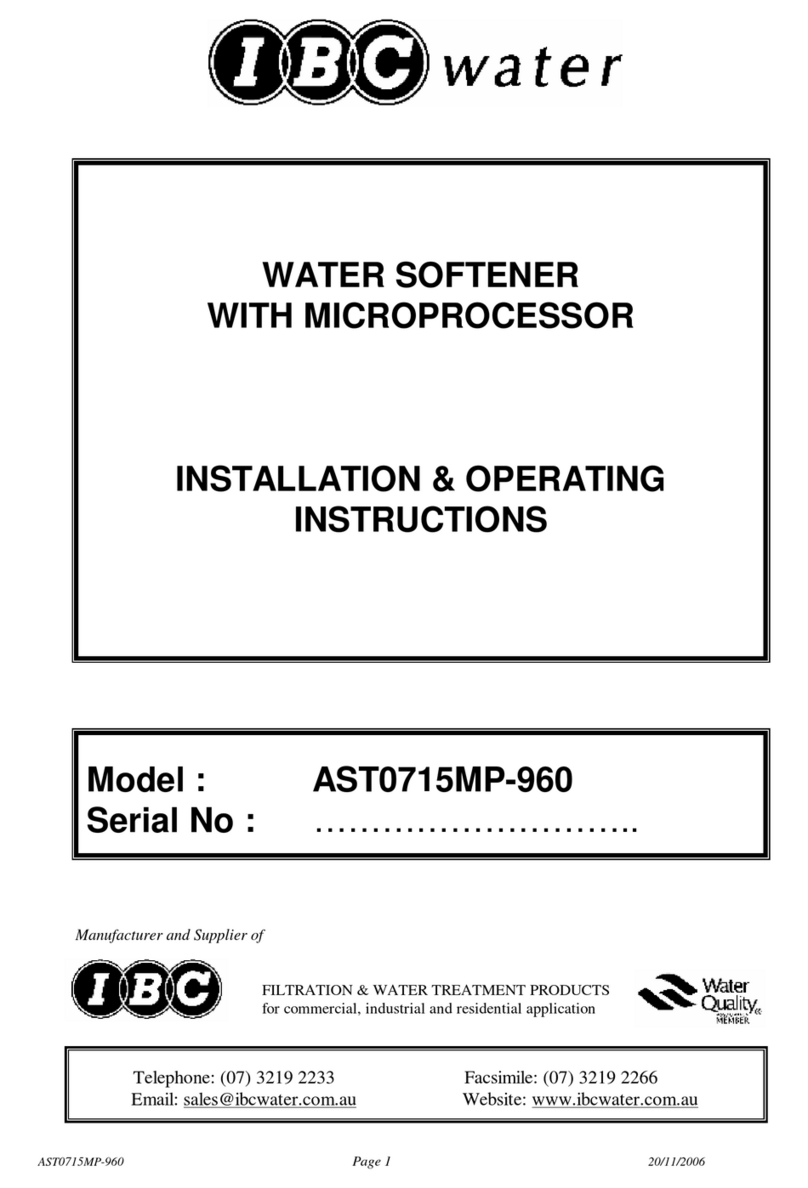
IBC Water
IBC Water AST0715MP-960 Installation & operating instructions
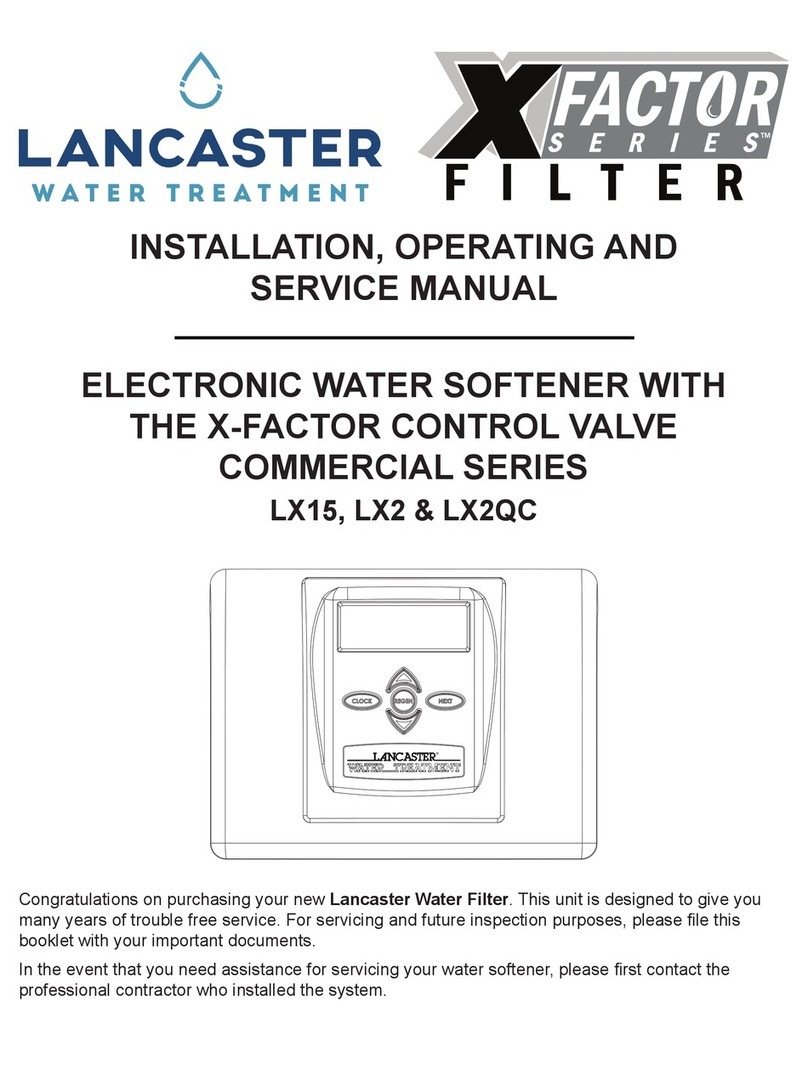
Lancaster Water Treatment
Lancaster Water Treatment X FACTOR LX15 Series Installation, operating and service manual
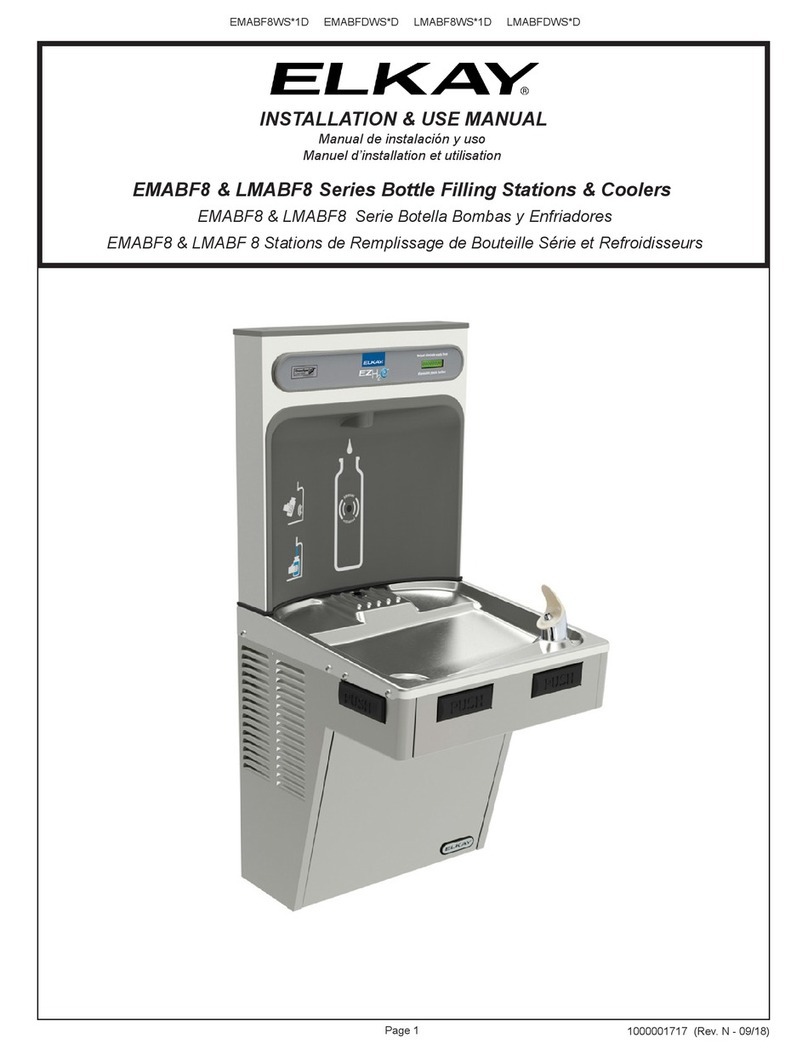
Elkay
Elkay EMABF8 Series Installation & use manual
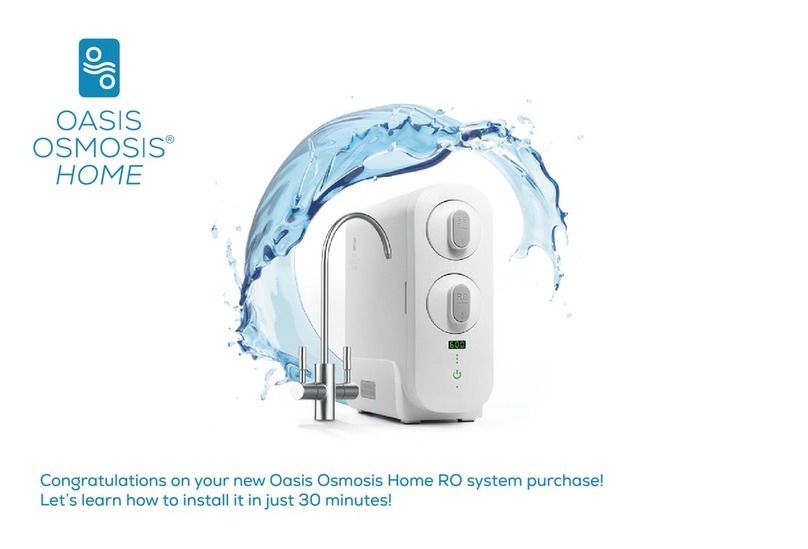
Oasis
Oasis Osmosis Home installation manual

Monarch Water
Monarch Water ULTIMATE MINI AQUA HE install guide
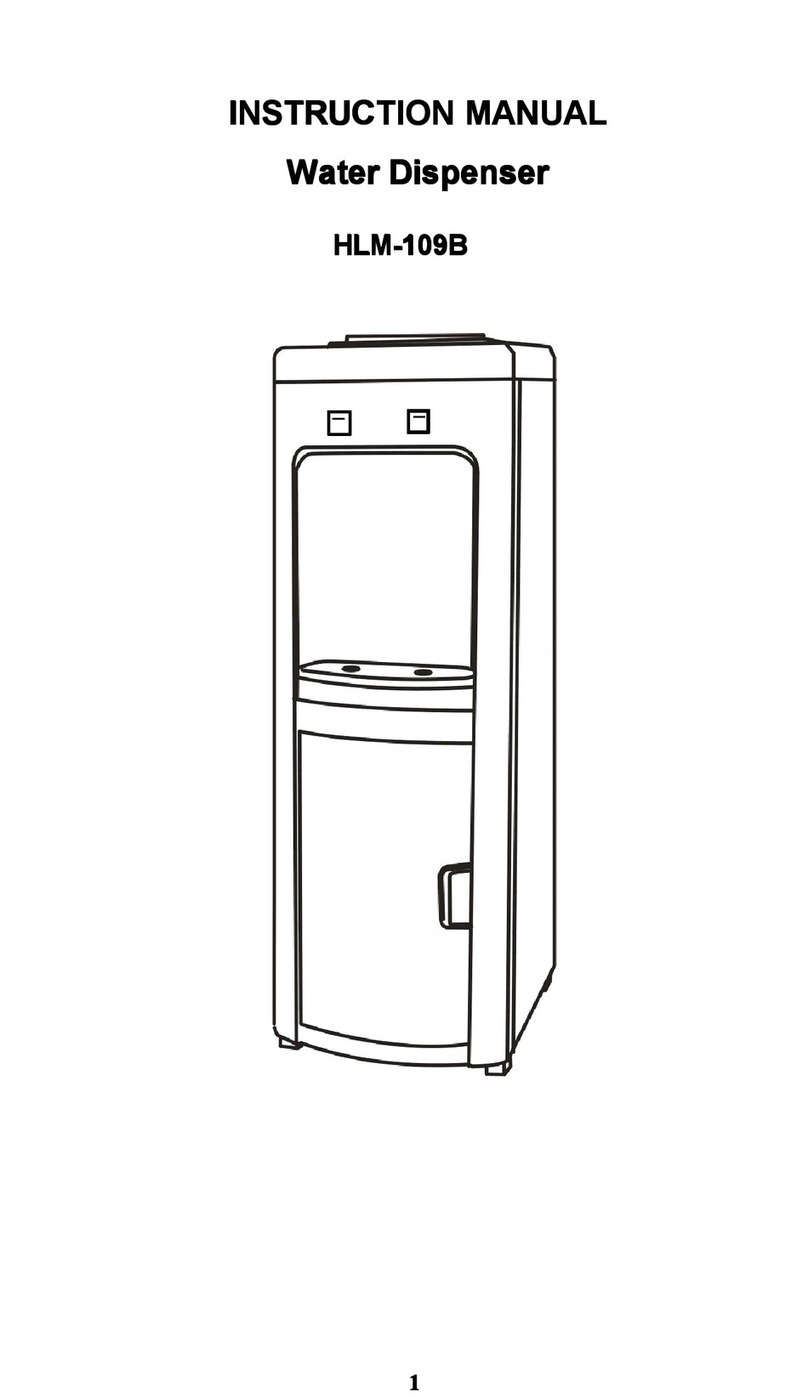
Haier
Haier HLM-109B instruction manual
